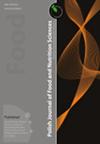Comparative Study on Drying Characteristics and Quality of Apple Cubes Dried in Two Different Microwave Dryers
IF 2.3
4区 农林科学
Q3 FOOD SCIENCE & TECHNOLOGY
引用次数: 0
Abstract
A rotary plate microwave dryer (RMD) and a newly-developed microwave convection coupled dryer (MCD) were used to dry apple cubes. The effects of microwave output power on drying, heating characteristics and quality attributes including scorching rate, color parameters, rehydration ratio, shrinkage, hardness, and sensory scores of the apple cubes were investigated and compared. The results showed that the microwave power required to complete drying in RMD was only 1/6 of that in MCD at the same microwave power density. Total drying time was 120, 60 and 30 min at 70, 210 and 350 W in RMD, respectively, while 160, 90, 80 and 60 min at 400; 800; 1,200; and 1,600 W in MCD, respectively. Compared with the products dried using hot air, the apple cubes dried in both dryers at the low microwave power had better rehydration capacity, less shrinkage and lower hardness as well as a * and b * value of color. Application of microwave power of over 800 W in MCD and over 210 W in RMD caused the increase in scorching rate as well as decreased the L * value and the sensory quality of the apple cubes. Microwave drying in MCD with temperature control improved the quality of the dried product. The microwave drying conditions suitable for the apple cubes were 400 W in MCD and 1,600 W in MCD with temperature control followed by 70 W in RMD; the products obtained under these three condition variants had superior or comparable quality to the products obtained upon conventional hot air-drying.两种不同微波干燥器干燥苹果块的干燥特性和质量比较研究
使用转盘式微波干燥器(RMD)和新开发的微波对流耦合干燥器(MCD)干燥苹果块。研究并比较了微波输出功率对苹果块的干燥、加热特性和质量属性(包括焦化率、颜色参数、复水率、收缩率、硬度和感官评分)的影响。结果表明,在相同的微波功率密度下,RMD 完成干燥所需的微波功率仅为 MCD 的 1/6。在 RMD 中,70、210 和 350 W 的总干燥时间分别为 120、60 和 30 分钟,而在 MCD 中,400、800、1,200 和 1,600 W 的总干燥时间分别为 160、90、80 和 60 分钟。与使用热空气干燥的产品相比,两种干燥器在低微波功率下干燥的苹果块具有更好的再水化能力、更小的收缩率、更低的硬度以及颜色的 a * 值和 b * 值。在 MCD 中使用超过 800 W 的微波功率和在 RMD 中使用超过 210 W 的微波功率会导致焦化率上升,并降低苹果块的 L * 值和感官质量。在有温度控制的 MCD 中进行微波干燥可提高干燥产品的质量。适合苹果块的微波干燥条件是在 MCD 中使用 400 W 微波,在 MCD 中使用 1 600 W 微波并控制温度,然后在 RMD 中使用 70 W 微波。
本文章由计算机程序翻译,如有差异,请以英文原文为准。
求助全文
约1分钟内获得全文
求助全文
来源期刊

Polish Journal of Food and Nutrition Sciences
FOOD SCIENCE & TECHNOLOGY-
CiteScore
4.30
自引率
12.50%
发文量
25
审稿时长
20 weeks
期刊介绍:
The Polish Journal of Food and Nutrition Sciences publishes original, basic and applied papers, reviews and short communications on fundamental and applied food research in the following Sections:
-Food Technology:
Innovative technology of food development including biotechnological and microbiological aspects
Effects of processing on food composition and nutritional value
-Food Chemistry:
Bioactive constituents of foods
Chemistry relating to major and minor components of food
Analytical methods
-Food Quality and Functionality:
Sensory methodologies
Functional properties of food
Food physics
Quality, storage and safety of food
-Nutritional Research Section:
Nutritional studies relating to major and minor components of food (excluding works related to questionnaire
surveys)
-“News” section:
Announcements of congresses
Miscellanea
 求助内容:
求助内容: 应助结果提醒方式:
应助结果提醒方式:


